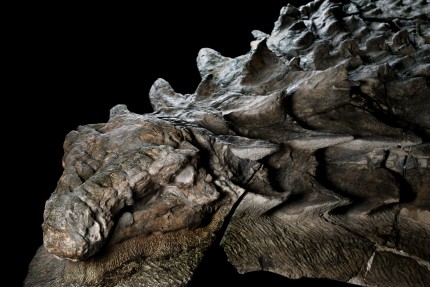
A dinosaur fossil that was discovered in a bitumen pit in Alberta, Canada, in 2011 is the best-preserved specimen of a nodosaur ever discovered, and it is truly a spectacle to behold. The herbivore died between 110 and 112 million years ago in a riverbed and was swept to sea where it was swiftly buried in the mud and sediment of the seabed. Resting on its back, the nodosaur’s soft tissues, armour plating and thorny ridges became mineralized, preserving its form in stone.
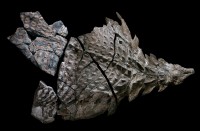 Scientists think the entire body was fossilized, but by the time mechanical excavator operator Shawn Funk unearthed it in the Millennium Mine, the front half of it from nose to hips, about nine feet long, was all that could be recovered. Nodosaurs averaged about 18 feet in length and weighed 3,000 pounds, so they were formidable creatures, although they lacked the flashy spiked tail club their ankylosaur cousins used to break the shins of would-be predators.
Scientists think the entire body was fossilized, but by the time mechanical excavator operator Shawn Funk unearthed it in the Millennium Mine, the front half of it from nose to hips, about nine feet long, was all that could be recovered. Nodosaurs averaged about 18 feet in length and weighed 3,000 pounds, so they were formidable creatures, although they lacked the flashy spiked tail club their ankylosaur cousins used to break the shins of would-be predators.
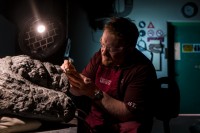 The nodosaur is now in the capable hands of the experts at the fossil prep lab at Alberta’s Royal Tyrrell Museum. They determined that it is a new species of nodosaur as well as the oldest dinosaur ever discovered in Alberta. The painstaking work of excavating the mineralized beast from the surrounding rock has been visible to the public through the lab gallery window since its discovery.
The nodosaur is now in the capable hands of the experts at the fossil prep lab at Alberta’s Royal Tyrrell Museum. They determined that it is a new species of nodosaur as well as the oldest dinosaur ever discovered in Alberta. The painstaking work of excavating the mineralized beast from the surrounding rock has been visible to the public through the lab gallery window since its discovery.
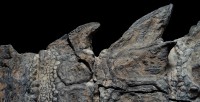 For those of us not in Alberta, National Geographic has been granted exclusive access to this extraordinary find. Photographer Robert Clark took many exceptional photographs, and even he, who has doubtless seen many wonders as a National Geographic photographer, was dumbfounded by the preservation of the nodosaur.
For those of us not in Alberta, National Geographic has been granted exclusive access to this extraordinary find. Photographer Robert Clark took many exceptional photographs, and even he, who has doubtless seen many wonders as a National Geographic photographer, was dumbfounded by the preservation of the nodosaur.
The more I look at it, the more mind-boggling it becomes. Fossilized remnants of skin still cover the bumpy armor plates dotting the animal’s skull. Its right forefoot lies by its side, its five digits splayed upward. I can count the scales on its sole. Caleb Brown, a postdoctoral researcher at the museum, grins at my astonishment. “We don’t just have a skeleton,” he tells me later. “We have a dinosaur as it would have been.”
For paleontologists the dinosaur’s amazing level of fossilization—caused by its rapid undersea burial—is as rare as winning the lottery. Usually just the bones and teeth are preserved, and only rarely do minerals replace soft tissues before they rot away. There’s also no guarantee that a fossil will keep its true-to-life shape. Feathered dinosaurs found in China, for example, were squished flat, and North America’s “mummified” duck-billed dinosaurs, among the most complete ever found, look withered and sun dried.
Paleobiologist Jakob Vinther, an expert on animal coloration from the U.K.’s University of Bristol, has studied some of the world’s best fossils for signs of the pigment melanin. But after four days of working on this one—delicately scraping off samples smaller than flecks of grated Parmesan—even he is astounded. The dinosaur is so well preserved that it “might have been walking around a couple of weeks ago,” Vinther says. “I’ve never seen anything like this.”
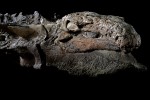 Some people are making Zuul comparisons, but scientists already snagged that little pop culture gem as the official name of an ankylosaur unearthed in Montana which also had spectacular soft-tissue fossilization. They called it Zuul crurivastator, meaning “Zuul, destroyer of shins,” which I think we can all agree is one of the all-time great feats of nomenclature. I think the Alberta nodosaur bears a more notable resemblance to the Gorn, of original Star Trek fame. That glaring blank eyesocket with the thorny brow ridge is so Gorny.
Some people are making Zuul comparisons, but scientists already snagged that little pop culture gem as the official name of an ankylosaur unearthed in Montana which also had spectacular soft-tissue fossilization. They called it Zuul crurivastator, meaning “Zuul, destroyer of shins,” which I think we can all agree is one of the all-time great feats of nomenclature. I think the Alberta nodosaur bears a more notable resemblance to the Gorn, of original Star Trek fame. That glaring blank eyesocket with the thorny brow ridge is so Gorny.
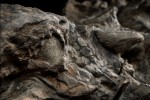 National Geographic has created a 3D virtual model of the nodosaur fossil that is one of the best I’ve ever seen. As you might expect, you can zoom in and out, turn it around and view it from different perspectives, but this one has tons of additional features. As you scroll, the parts are exploded and labeled so you can get a thorough idea of what bits go where and what function they performed. A drawing of a complete nodosaur as it would have looked in life is used to diagram what parts of it have survived in the fossil.
National Geographic has created a 3D virtual model of the nodosaur fossil that is one of the best I’ve ever seen. As you might expect, you can zoom in and out, turn it around and view it from different perspectives, but this one has tons of additional features. As you scroll, the parts are exploded and labeled so you can get a thorough idea of what bits go where and what function they performed. A drawing of a complete nodosaur as it would have looked in life is used to diagram what parts of it have survived in the fossil.